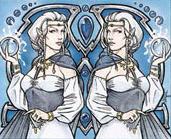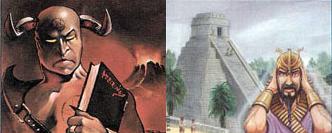
At the beginning of this "Magic Theory From The Ground Up" series, our heroes Timmy and Jimmy started with the simplest form of Magic possible, and we analyzed it to build some basic game concepts. Over time, Timmy and Jimmy have been working their way up to playing a regular game of Magic, and they're about to take their biggest step yet - full, randomized decks. Are they ready to improve their skills and their understanding of the game? Let's take a look!
Consistency, Redundancy, Versatility
Timmy and Jimmy are still playing their 7-card decks, giving them complete control over the cards they can use in the game. But they know they're not true Magic players yet, and that they eventually need to take a couple more steps. They decide to try out introducing randomness first - each of them makes a full 60-card deck, but they only draw 7 cards at the beginning of the game and play with those. Timmy and Jimmy immediately begin packing more fun cards into their decks.
The first problem is immediately clear: they didn't bother adding extra lands. They find themselves unable to play any cards at all. In response, they then start making half of their decks lands, but it turns out they end up drawing too much. A couple of hours later, they finally find a reasonable balance and can actually play games.
Because mana is one of the key resources in Magic, it's fundamentally important to make sure you get the right amount of mana in a game. Too little means you can't do anything, and too much means you don't have anything to do. The set of mana sources in a deck is known as the manabase, and every good player knows that finding the right manabase is one of the main challenges of building a strong deck. Timmy and Jimmy aren't too concerned with the finer points of mana right now, though - all they want is to actually be able to play a decent game.
Back when they played 7-card hands, they had total control over what their expected progress looked like. Now, with all these random cards in their decks, each opening hand produces a very different outcome, leading to lots of variance. This means that there's a very wide range of possible outcomes for their decks, and this is bad because their games start looking more like rock-paper-scissors.
What Timmy and Jimmy want is some sense of consistency. Consistency is the idea that the progress of a deck should play out as closely as possible to some intended plan of progress. A fast aggro deck should almost always be playing creatures early, and a control deck should almost always have enough answers in hand. If there's too much variance, then the purpose of the deck becomes meaningless.
Frustrated by the gods of probability, Timmy and Jimmy start building decks by a certain formula:
1) Create an ideal 7-card hand.
2) Multiply everything by 8 and fill in the remaining 4 slots with lands.

Some wizards also like redundancy
when it comes to the opposite sex.
Of course, this still doesn't guarantee that they'll get the card they need. Sometimes, they'll have a resource when they needed a threat, or a threat when they needed an answer, and so on. So how can they further fix this? They turn back to an earlier concept they learned - versatility. By playing cards with multiple functions, they make themselves more likely to have the correct combination of resources, threats, and answers.
Remember that making progress is easier when you have a lineup and resource advantage over your opponent. In order to create consistency in the way your deck progresses, you need to give yourself reliable ways of achieving advantages. Both redundancy and versatility give you that reliability you need.
Card Tempo
It doesn't take long before Timmy and Jimmy realize that including randomness makes little sense if you don't also include the card-drawing aspect of Magic. So they make their final step and start playing their first regular game of Magic - something totally unlike their previous experiences. To better understand the difference, let's analyze the process of drawing a card.
In terms of resources, each draw phase converts a card in library to a card in hand, where it becomes readily usable as a spell or land. Players need these cards in hand in order to convert them into other resources or effects. Each turn yields an additional card in hand, and this is the default card tempo in Magic. As long as this tempo doesn't change, both player will always have seen roughly the same amount of cards in hand.
Drawing more cards smooths out the randomness factor in Magic. If you started the game with 59 out of your 60 cards, your games would pretty much be identical every time. When you start out with only 7 cards, there's much more room for variance. Thus, as the game goes on, you get closer and closer to a "typical sample" of your deck. Similarly, the faster your card tempo, the faster you approach that average sample. This means that drawing more cards helps you improve consistency within the game, though it will come at some cost.
But drawing cards faster does more than improve your consistency. If you have more card tempo than your opponent, you're generally getting more cards than can help you out - more answers, more threats, more resources, etc. You also have more options at your disposal. Overall, more cards means you have a bigger arsenal to work with. And this is the underlying idea behind card advantage.
Card Advantage
Like any other resource, card advantage is gained by accelerating your own card tempo or decreasing your opponent's card tempo. The classic example is Ancestral Recall, which lets you draw three cards for the price of one card and :symu:. Every card-drawing spell increases the portion of the deck you've seen, granting you some form of card advantage. (I'll explain this more in a bit.) Meanwhile, effects that deprive your opponent of cards is a means of decreasing his card tempo. A card like Plagiarize simultaneously takes a card away from your opponent while giving one to you.
Strict card advantage looks only at this process of drawing cards. An expanded version of card advantage (as most players are familiar with) also looks at cards that have already been converted into other resources. Mass destruction, for example, is an exchange between a single card (e.g. Pyroclasm) and multiple cards of an opponent. However, those dead creatures are more than just cards; they are threats that have been created from cards and mana. Before they were put into play, though, they were merely potential threats. Thus, there is a subtle difference between these two concepts of card advantage that is often overlooked.
Attacking someone's card tempo is like attacking the source of a problem. If your opponent is not drawing as many cards as you are, you are statistically likely to gain an advantage in other areas (threats, answers, resources) but it doesn't directly affect board position, and it doesn't guarantee your opponent won't draw something you don't want to see. On the other hand, using removal on a permanent does nothing to the opponent's card tempo, but it affects board position and gives you control over what you're trading with. Both methods aim to result in a positive lineup advantage for you, but they function in very different ways.

Mommy, make it stop! The bad man is staring at me!
I mentioned above that every card-drawing spell grants you some form of card advantage. Those of you who study card advantage from a numerical standpoint will disagree with this statement, claiming that a 1-for-1 draw gives you no card advantage - you're ending up with the same number of cards that you started with. While that is true, it overlooks the fact that in the end, a deck has to win. Not every card in a deck is necessary for you to win, and in fact, most aren't.
What do I mean by that? Back when Timmy and Jimmy were playing with 7-card decks, they had exactly the cards that they needed to win with. They had complete control over what they played over the course of a game. But randomness messes all of that up. Because of randomness, players can't choose what they want to get; they can only influence it.
At any point in the game, there are cards in your deck that you need at the moment and others that you don't. It would be nice if we always drew exactly what we needed, but that's just a dream. No matter how much redundancy and versatility you build into your deck, there will be times that you won't get what you need. The only way to get those cards is through drawing, either by drawing more, or by drawing exactly what you want.
Drawing more cards gives you a chance at drawing what you need. In a game, the player who looks at the most cards has the best chance of getting the right cards (assuming the players have an equal amount of "right" cards). Even a 1-for-1 card draw increases the number of cards you're seeing, although it's definitely coming at a cost (the mana spent, for example). And of course, every slot you take up with a card-drawing spell could have been used for putting in more of those "right" cards. Somewhere in there, though, you'll find a balance between how many you'll want of each.
So unless you're drawing a lot of cards, you would rather just draw exactly what you need. This is why tutors are powerful: they violate the inherent randomness of Magic. Why hope to get the perfect topdeck when you can simply Demonic Tutor for it?
So there are two components of card drawing: the quantity of cards drawn, and the quality of cards drawn. Improving quantity gives you more options and more ammunition, but you don't get any guarantees about what you draw. Improving quality gives you more choice over what you get and when you get it, but you're still stuck with the same amount of options.
Although most decks prefer leaving it up to chance and going for quantity, quality is still a significant factor elsewhere. For example, if you can extract all of an opponent's threats from his deck, then he can no longer win, regardless of the number of cards he draws. And combo decks generally prefer tutors over card draw because they need to guarantee a specific card quickly; just increasing their chances of drawing a card simply isn't as good.
Welcome to the Real World, Timmy
Now that Timmy and Jimmy have graduated to the real world, the game has drastically changed. A lot of what they knew before will still be useful, but there's so much more ahead of them. The theory of card advantage, one of the most difficult Magic concepts to properly analyze, is far from complete. When we catch up with Timmy and Jimmy next time, we'll be taking a deeper look at the expanded version of card advantage, as well as the idea of virtual card advantage. See you next time!
-fadeblue
Credits: Goblinboy (editing), iloveatogs (banner)
Comments